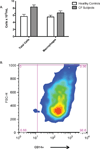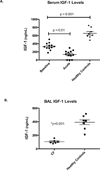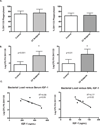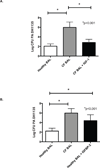Low levels of insulin-like growth factor-1 contribute to alveolar macrophage dysfunction in cystic fibrosis
- PMID: 23698746
- PMCID: PMC3691334
- DOI: 10.4049/jimmunol.1300221
Low levels of insulin-like growth factor-1 contribute to alveolar macrophage dysfunction in cystic fibrosis
Abstract
Alveolar macrophages are major contributors to lung innate immunity. Although alveolar macrophages from cystic fibrosis (CF) transmembrane conductance regulator(-/-) mice have impaired function, no study has investigated primary alveolar macrophages in adults with CF. CF patients have low levels of insulin-like growth factor 1 (IGF-1), and our prior studies demonstrate a relationship between IGF-1 and macrophage function. We hypothesize that reduced IGF-1 in CF leads to impaired alveolar macrophage function and chronic infections. Serum and bronchoalveolar lavage (BAL) samples were obtained from eight CF subjects and eight healthy subjects. Macrophages were isolated from BAL fluid. We measured the ability of alveolar macrophages to kill Pseudomonas aeruginosa. Subsequently, macrophages were incubated with IGF-1 prior to inoculation with bacteria to determine the effect of IGF-1 on bacterial killing. We found a significant decrease in bacterial killing by CF alveolar macrophages compared with control subjects. CF subjects had lower serum and BAL IGF-1 levels compared with healthy control subjects. Exposure to IGF-1 enhanced alveolar macrophage macrophages in both groups. Finally, exposing healthy alveolar macrophages to CF BAL fluid decreased bacterial killing, and this was reversed by the addition of IGF-1, whereas IGF-1 blockade worsened bacterial killing. Our studies demonstrate that alveolar macrophage function is impaired in patients with CF. Reductions in IGF-1 levels in CF contribute to the impaired alveolar macrophage function. Exposure to IGF-1 ex vivo results in improved function of CF alveolar macrophages. Further studies are needed to determine whether alveolar macrophage function can be enhanced in vivo with IGF-1 treatment.
Figures






References
-
- Rowe SM, Miller S, Sorscher EJ. Cystic fibrosis. N Engl J Med. 2005;352:1992–2001. - PubMed
-
- Di A, Brown ME, Deriy LV, Li C, Szeto FL, Chen Y, Huang P, Tong J, Naren AP, Bindokas V, et al. CFTR regulates phagosome acidification in macrophages and alters bactericidal activity. Nat Cell Biol. 2006;8:933–944. - PubMed
Publication types
MeSH terms
Substances
Grants and funding
LinkOut - more resources
Full Text Sources
Other Literature Sources
Medical
Miscellaneous

